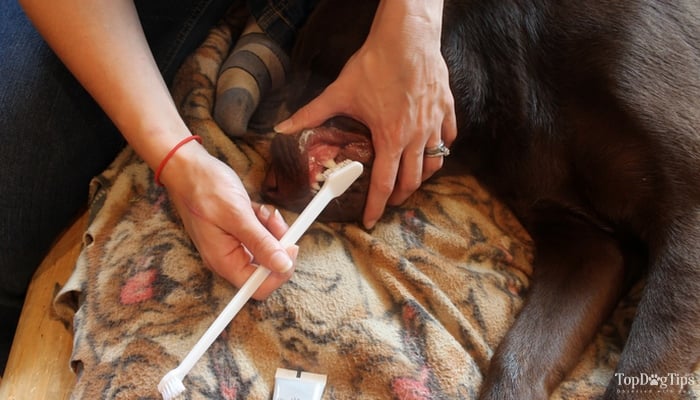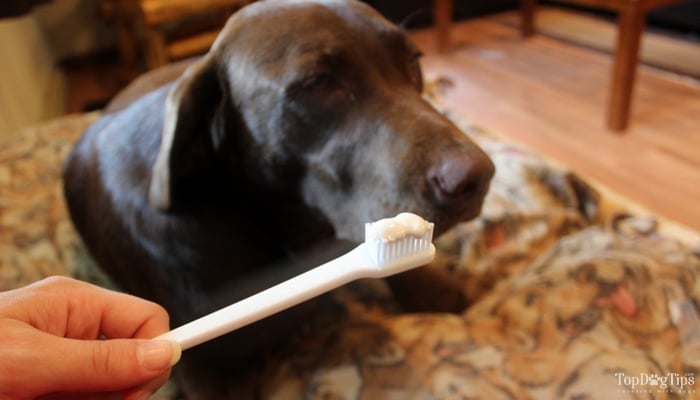Periodontal disease is the most common health condition seen in adult dogs. It's also the most preventable health issue. Many pet owners don't realize that learning how to brush a dog's teeth could actually add years to their dog's life.
Table of Contents
Why Brush a Dog's Teeth
Some people assume that all dogs have bad breath, but that's a misconception. Most dogs already show signs of periodontal disease by age 3. The buildup of plaque and tartar in their mouth fosters the growth of bacteria, which is what leads to bad breath in dogs. Brushing your dog's teeth can drastically reduce the smell of their breath.
But bad breath isn't even the major problem here. More importantly, keeping up with your dog's oral hygiene can aid in his overall health and well-being, going as far as preventing heart problems. Neglecting your dog's mouth health could lead to conditions like:
- destruction to and loss of the gum tissue and bone around the teeth
- fistulas (holes leading from the oral cavity to the nasal passage)
- osteomyelitis (bone infection)
- weakened jaw bone
- bacteria entering the blood stream and having a negative effect on the dog's heart, liver and kidneys
In my video above, I explain the supplies you'll need to learn how to brush a dog's teeth. They aren't expensive, but you need products specifically designed for dogs and not humans. A toothbrush made for people will not contour to your dog's mouth, and human toothpaste has chemicals in it that are toxic to canines.
How to Brush a Dog's Teeth
1. Choose the Right Time
When brushing a dog's teeth, it's best to do it during a time that your pet is relaxed and calm. You'll have a much harder time doing it if the dog is full of energy. Personally, I try to do it after an evening play session when my dogs are tired. I wait until they've been relaxing for at least 15 minutes and then we begin brushing.
For this reason, you need to set aside a special time every day to brush your dog's teeth. I like to do it right before bedtime. My dogs are tired from their busy day, and it's easy to remember as it's the same time I brush my own teeth.
Some pet owners claim they don't have the time for daily brushing of their dogs' teeth. And yes, brushing a few days a week is better than no brushing at all, but in order to keep your pet's health top shape, you need to do it every single day. 24+ hours is enough for bacteria to start growing.
It's easiest to work with a puppy, because you're essentially starting with a blank slate. Their teeth are clean and healthy, and you can help keep them that way for the rest of dog's life. However, if you adopt an adult dog, you still need to start caring for their oral hygiene immediately; it may be more difficult, but most dogs get used to it eventually.
2. Get Your Dog Used to the Process First
As I mention in my video, if you're attempting to brush a dog's teeth, you need to be confident in your abilities. If you're nervous, your dog will sense that. Fortunately, there's nothing to be worried about – you're not going to hurt your pet.
When you're just beginning, or rather when you dog is just getting used to this, you'll need to ease him into the brushing process gradually (which may take 1-2 weeks), and following steps like these:
- Touch the dog's mouth
- Put your fingers in the dog's mouth, rub his gums
- Use some toothpaste on your finger
- Use a toothbrush instead of your finger
So, start by simply touching the outside of the dog's mouth. When he's completely comfortable with that, you can put your fingers in his mouth. Use one finger to rub his teeth and gums. Don't worry if the dog fidgets or tries to get up and walk away from you. This is to be expected.
In the beginning, try these steps multiple times per day. The more often you can do it the better. The longer you wait between these trials, the more likely it is that your dog will not put the pieces together. If you try to work with him every few hours throughout the day, he'll associate what you're doing and eventually allow you access to his mouth.
Once you've gained your dog's trust and he allows you to access his mouth, begin working with a toothpaste. Put a little bit on your finger and let your pup lick it off. When he's completely comfortable with the toothpaste, you can add in the toothbrush.
Getting your pet comfortable with the toothpaste and toothbrush may take a couple of weeks. Don't get frustrated. When learning how to brush a dog's teeth you need to be patient and stay calm. If you become anxious or frustrated, your dog will pick up on that.
3. Assuming the Position
You'll need to hold your dog firmly but gently. Tip him onto his side (like you see in the above photo) and gently hold him.
Don't apply pressure. This could make your dog feel intimidated. Do not place your arm or leg over your pet to hold him down, and don't try to restrain him in any way.
If the dog gets up to leave, let him do it. You can try again at another time when he is feeling more comfortable. Forcing the dog too much will make the process harder.
4. How to Brush a Dog's Teeth
Now for the actual process of brushing. It isn't difficult once you get your pet used to the idea. It's similar to brushing your own teeth.
Start by brushing one or two teeth at a time – whatever your dog will let you do. The front side of the back teeth and the canine teeth should be your first priority.
Dogs have a rough tongue. It helps scrape some of the plaque off of the interior of their teeth. The interiors still need to be brushed, but in the beginning, you can focus on the outside of the teeth and the canines.
You want to apply slight pressure and move the brush in small circles. Just like when you brush your own teeth, if you apply to much pressure, you could damage your dog's gums. Brushing at a 45° degree angle will allow the toothbrush to clean the gums and teeth properly.
Toothpaste formulated for dogs, which you need to be using, does not require rinsing like toothpaste for humans. Once you've brushed your pet's teeth for about 2-3 minutes, you can simply let the dog lick the remaining toothpaste off his teeth and your task is finished.
5. Best Supplies for Dog's Oral Hygiene
You only need a dog toothbrush and toothpaste to brush your pet's teeth. However, for those times when you're unable to do this, there are several other canine oral hygiene products you can use, such as water additives and dental gels. Below are some of the best toothpastes, toothbrushes and other supplies that I found most effective in the past.
| Preview | Product | Rating | |
|---|---|---|---|

|
Vet's Best Dog Toothbrush & Toothpaste Kit -... | 43,525 Reviews | Check Price |

|
Arm & Hammer for Pets Clinical Care Dental... | 5,657 Reviews | Check Price |

|
TropiClean Fresh Breath for Dogs | No Brush Dental... | 9,535 Reviews | Check Price |

|
Petlab Co. Dog Dental Formula - Keep Dog Breath... | 18,369 Reviews | Check Price |
READ NEXT: 11 Science-Based Dog Teeth Care Tips
Disclosure: We may earn affiliate commissions at no cost to you from the links on this page. This did not affect our assessment of products. Read more here and find full disclosure here.















